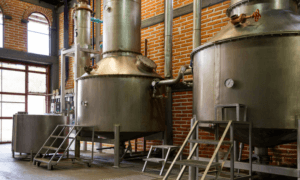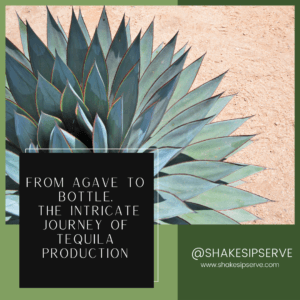Mastering the Craft: Tequila Production from Agave to Bottle
In the rolling hills of Jalisco, Mexico, where the sun kisses the earth and the blue agave plant thrives, a time-honored tradition unfolds – the production of tequila. Join us on a fascinating journey as we uncover the intricate process behind crafting Mexico’s iconic spirit, from the cultivation of agave plants to the art of distillation and aging.
Tequila production, a meticulous craft steeped in tradition, encompasses the cultivation of blue agave, precise harvesting, expert distillation, and careful aging, culminating in the creation of Mexico’s iconic spirit.
The story of tequila transcends the clinking of glasses and the burst of citrus in a Margarita. It begins nestled amidst the rolling hills and fertile plains of Jalisco, Mexico, where a journey of patience, skill, and transformation unfolds. Our tale starts not with the spirit itself, but with its heart: the mighty blue agave plant.
Agave Tequilana Weber: A Prickly Gem of the Mexican Landscape
Imagine towering stalks erupting from a rosette of spiky blue-green leaves, glistening under the warm Mexican sun. This is the majestic Agave tequilana Weber, the sole source of true tequila. Cultivated in the rich volcanic soils of Jalisco and designated regions of Mexico, these succulent plants are more than just a pretty sight; they are the foundation upon which a celebrated spirit is built.
A Labor of Love: The Art of Agave Cultivation
Agave cultivation is an art form passed down through generations. Jimadores, the skilled agave farmers, possess an intimate understanding of the plant’s life cycle. Their patience and dedication are crucial, as these spiky beauties take their time to mature. Some varieties require a staggering eight years of careful nurturing before they are ready for harvest. During this time, the jimadores meticulously tend to the plants, ensuring they receive the perfect balance of nutrients, water, and sunlight. It’s a delicate dance, for these factors directly influence the agave’s development, ultimately shaping the character of the tequila it will yield.
A Symphony of Sweetness: Nature’s Gift to Tequila
As the agave matures, a fascinating transformation occurs within its heart, the piña. This bulbous core concentrates a unique blend of sugars, particularly fructose and inulin. These sugars become the building blocks for the future tequila, influencing its fermentability and ultimately, its final flavor profile. Imagine the agave’s journey as a symphony; the careful cultivation by the jimadores sets the stage, and the natural sugars within the piña become the musical notes that will eventually contribute to the tequila’s harmonious complexity.
A Glimpse Ahead: From Agave to Spirit
The story of tequila is far from over. The journey continues as the harvested agave hearts embark on their next chapter – a transformation from succulent plant to the celebrated spirit we know and love. Join us as we delve deeper into this fascinating process, exploring the art of extraction, fermentation, distillation, and finally, the aging that elevates tequila into its various expressions. So, raise a metaphorical glass to the blue agave plant, the heart and soul of tequila, and prepare to be captivated by the magic that unfolds.
The agave’s journey from field to spirit takes a crucial turn at harvest. This is a time-honored tradition, a testament to the skill and dedication of the jimadores.
The Selective Hand: Choosing the Perfect Agave
Reaching maturity after years of meticulous care, the agave plants are finally ready for harvest. This is no ordinary task; it requires a practiced eye and a deep understanding of the agave’s life cycle. The jimadores, armed with their specialized coas (scraping tools) and machetes, meticulously select only the ripest and highest-quality plants. Imagine them navigating the fields, their expertise allowing them to discern the subtle signs that an agave heart is at its peak.
From Spiky Exterior to Sweet Reward: Unveiling the Piña
With practiced movements, the jimadores remove the spiky leaves, revealing the piña – the heart of the agave plant. This bulbous core, resembling a giant pineapple (hence the name), holds the key to tequila’s future. The jimadores treat the piñas with respect, for they understand the precious cargo they carry.
The Transformation Begins: Cooking and Unlocking Flavors
The piñas then embark on their journey to the distillery. Here, they undergo a crucial step – cooking or baking. Imagine the transformation that occurs as these hearts are subjected to intense heat, either in traditional brick ovens or modern autoclaves. This process, far from simply being a culinary exercise, serves a vital purpose. The heat breaks down the complex starches within the piña, converting them into simpler, fermentable sugars. These sugars become the building blocks for the future tequila, the fuel that will allow the yeast to work its magic in the next stage of the process.
A Glimpse of What’s to Come: Preparing for Fermentation
The cooking process also plays a significant role in unlocking the unique flavors and aromas of the agave plant. The caramelized notes that sometimes grace a tequila can be attributed to this stage. Once cooked, the piñas are trimmed, cleaned, and prepared for the next chapter in their transformation – fermentation. Here, the simple sugars released by the cooking process will become the playground for yeast, converting them into alcohol and setting the stage for the birth of tequila.
Fermentation
After cooking, the agave juices are extracted from the piñas and transferred to fermentation tanks, where they are combined with water and yeast to initiate the fermentation process. Fermentation is a natural biological process in which yeast converts sugars into alcohol and carbon dioxide, producing heat and a variety of flavorful compounds in the process.
During fermentation, the agave sugars are transformed into alcohol, creating a liquid known as mosto or wort. Depending on the desired style of tequila, fermentation may take anywhere from a few days to a week to complete. Throughout this time, the fermenting liquid undergoes a series of chemical changes, resulting in the development of complex flavors and aromas that will carry through to the finished tequila.
Distillation
Once fermentation is complete, the mosto is distilled to separate the alcohol from the water and other impurities. Distillation is a process that relies on heat and evaporation to concentrate the alcohol content of the liquid, resulting in a clear and flavorful spirit known as blanco or silver tequila.
Traditional tequila production utilizes copper pot stills, which are heated to boil the fermented liquid and separate the alcohol vapor from the water and solids. The vapor is then condensed back into liquid form, resulting in a distillate with a higher alcohol content and a more refined flavor profile. Depending on the desired style of tequila, the distillation process may be repeated multiple times to achieve the desired purity and character.
Aging
After distillation, some tequilas are aged in oak barrels to enhance their flavor and complexity. Aging is a process that allows the tequila to interact with the wood, imparting unique flavors and aromas that develop over time. The length of aging and the type of barrel used can greatly influence the final character of the tequila, ranging from the crisp and vibrant flavors of blanco tequila to the rich and complex notes of añejo and extra añejo tequilas.
Tequilas that are aged for less than two months are classified as joven or gold tequilas, while those aged between two months and one year are known as reposado tequilas. Tequilas aged for one to three years are categorized as añejo tequilas, while those aged for more than three years are designated as extra añejo tequilas. Each style of tequila offers its own unique flavor profile and sensory experience, making aging a crucial step in tequila production.
In conclusion, the production of tequila is a labor of love that combines art, science, and tradition to create a spirit that is truly unique. From the cultivation of agave plants to the art of distillation and aging, every step of the process contributes to the rich and complex flavors that define Mexico’s iconic spirit. So the next time you raise a glass of tequila, take a moment to appreciate the centuries-old tradition and craftsmanship that went into creating this beloved elixir.
-
Read more:
Immerse Yourself In Tequila Culture : Traditions, Festivals, And Music
Unveiling The Essence Of Tequila : An In-Depth Exploration Of Mexico’s Iconic Spirit
Savoring Responsibly: Tips For Enjoying Tequila With Care And Sustainability
A Guide To Tequila Brands : From Traditional To Ultra-Premium
Elevate Your Dining Experience: Tequila And Food Pairing For Every Course
Crafting The Perfect Tequila Cocktails: Crafting Timeless Recipes
Savoring The Spirit : How To Drink Tequila With Style And Sophistication
Exploring The Heartlands Of Tequila: A Journey Through Jalisco And Its Highlands Vs. Lowlands
Exploring The Spectrum Of Tequila : A Guide To Its Diverse Types
From Agave To Bottle: The Intricate Journey Of Tequila Production
Tequila And Mezcal: Deeply Rooted From The Mexican Culture
Tequila: A Toast To Tradition And TerroirDisclaimer: This post contains affiliate links. If you purchase through these links, I may earn a small commission at no additional cost to you.


